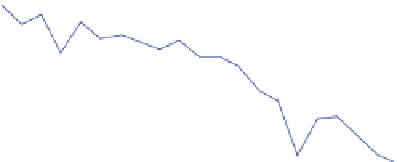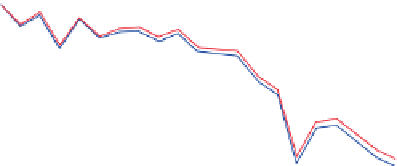Geology Reference
In-Depth Information
microwave frequency used, the 11 algorithms are grouped
into a low‐frequency group (NORSEX, UMass‐AES,
Cal/Val, and BRI) and a high‐frequency group
(NORSEX85, N90GHz, TUD, and ASI). The rest of the
algorithms use both low‐ and high‐frequency channels.
In a recent study, L. Pedersen of the Danish
Meteorological Institute and N. Ivanova of Nansen
Environmental and Remote Sensing Center calculated
the ice area and extent in the Arctic from 1995 to 2010
using five sea ice concentration algorithms (personal
communication). Definitions of ice area and extent are
presented in the following section. The five algorithms are
NORSEX, NASA Team, UMass‐AES, Bristol, and TUD
(see section 10.2.2. for full names and references). Results
are presented in Figure 10.25. Two sets are presented;
one from using the original tie points provided with the
14
14
UMass-AES
NORSEX
13
13
UMass-AES
NORSEX
12
12
Bristol & TUD
Bristol
11
11
NASA team
TUD
10
10
NASA team
9
9
Using original tie points
Using original tie points
8
8
1995
2000
2005
2010
1995
2000
2005
2010
14
14
UMass-AES & TUD
13
13
Bristol &
NASA team
12
12
UMass-AES & NORSEX
Bristol & TUD
11
11
NORSEX
10
10
NASA team
9
9
Using adapted tie points
Using adapted tie points
8
8
2000
1995
2000
1995
2005
2010
2005
2010
Figure 10.25
Annual variations of sea ice area and extent in the Arctic, estimated from five ice concentration
algorithms: NORSEX, NASA Team, UMass‐AES, Bristol, and TUD. Two sets are presented: one from using the
algorithms with the original tie points provided with each algorithm and the second with new common tie points
obtained within the framework of ESA CCI project. The graphs are modified versions from an original set courtesy
of L. Pedersen and N. Ivanova.



































